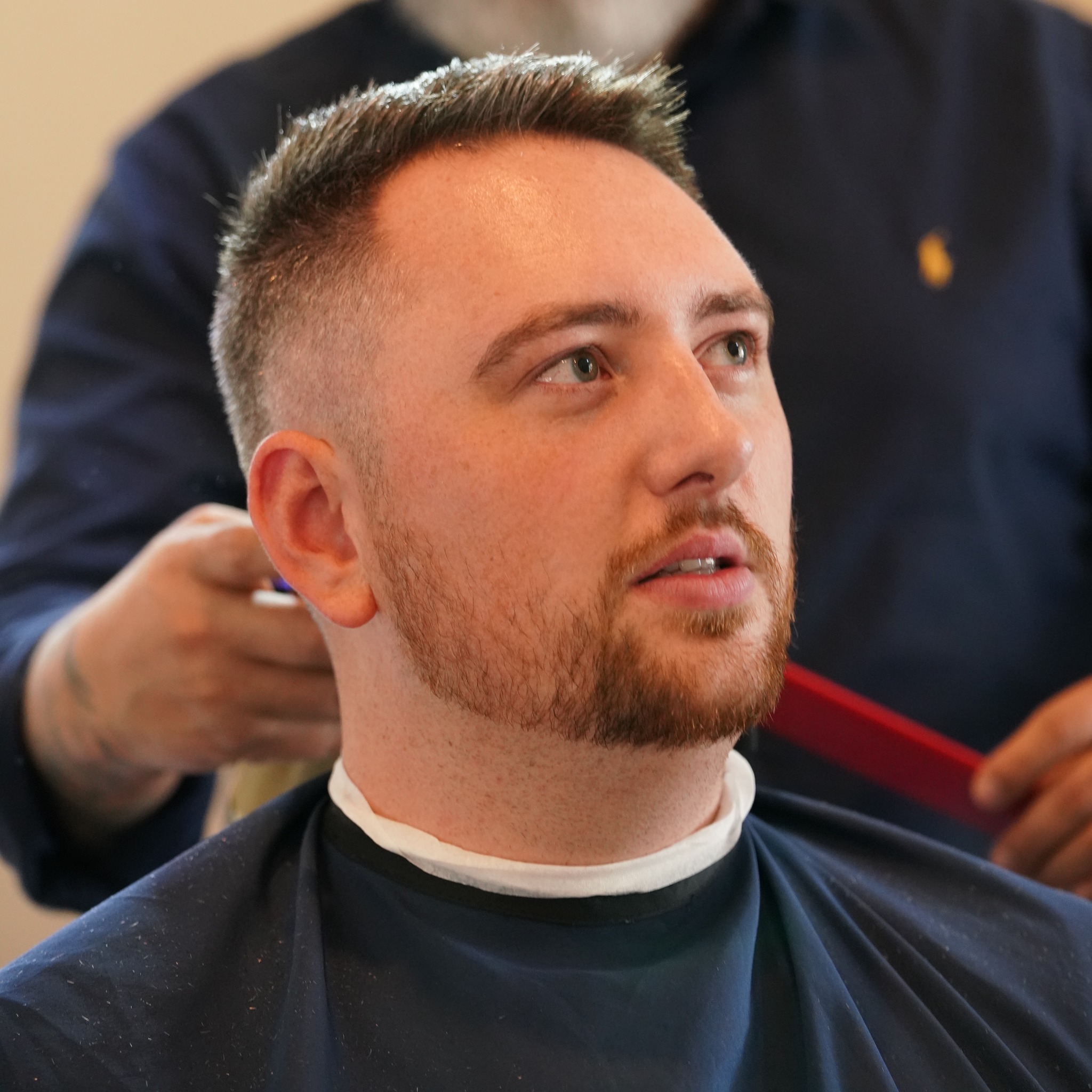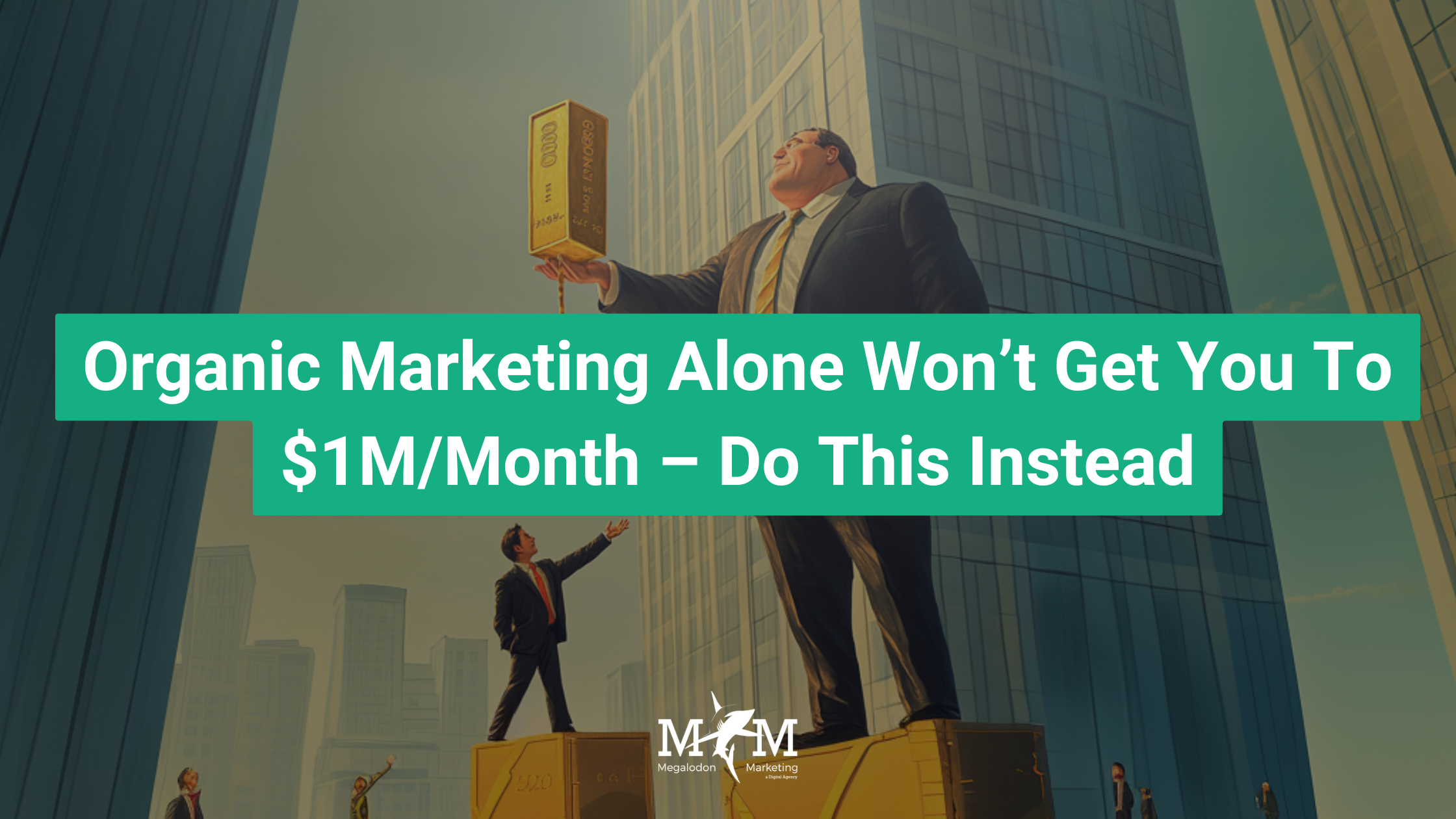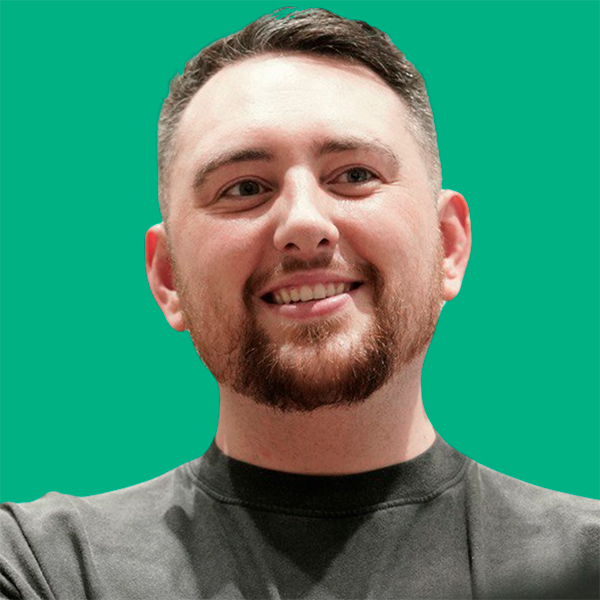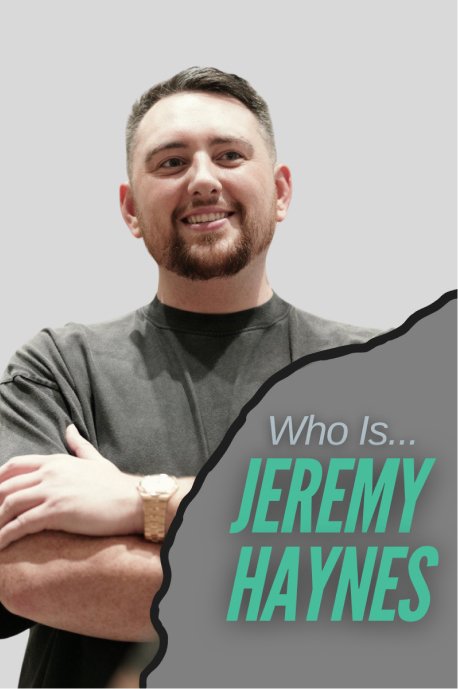I hope you enjoy reading this blog post. If you want my team to just do your marketing for you, click here.

I hope you enjoy reading this blog post. If you want my team to just do your marketing for you, click here.
Author: Jeremy Haynes | founder of Megalodon Marketing.

Earnings Disclaimer: You have a .1% probability of hitting million dollar months according to the US Bureau of Labor Statistics. As stated by law, we can not and do not make any guarantees about your own ability to get results or earn any money with our ideas, information, programs or strategies. We don’t know you and, besides, your results in life are up to you. We’re here to help by giving you our greatest strategies to move you forward, faster. However, nothing on this page or any of our websites or emails is a promise or guarantee of future earnings. Any financial numbers referenced here, or on any of our sites or emails, are simply estimates or projections or past results, and should not be considered exact, actual or as a promise of potential earnings – all numbers are illustrative only.
If you’re still exclusively relying on organic marketing to grow your business, you’re leaving a massive amount of money on the table. And chances are, you already know it. Hitting million-dollar months demands a more robust, predictable system. No matter how much you’re cranking out your social posts, or how many followers you’ve gained, you won’t crack the code to consistent, long-term scale without paid advertising. That’s what this entire article is about: transitioning from organic-only strategies to unstoppable paid campaigns that pave your way to $1M per month in revenue.
If you’re exclusively using organic methods—posting daily, engaging with your audience, maybe dropping your offer in DMs or e-mail newsletters—you already know how up-and-down it can be. One month you close five figures in new business from a viral tweet, the next month you don’t see that same magic.
You can pull off decent numbers organically if you’re active and your content resonates. I know some people who have legitimately hit $300K, $400K, $500K months just from organic. But the real question is: Can you hit a million dollars a month—consistently—with purely organic marketing? Probably not. Sure, you might find a rare outlier or two who claim they’ve cracked that code. But for most entrepreneurs, organic alone is like a rollercoaster: it’s unpredictable, it’s reliant on the seasons, the algorithms, and your ability to manually crank out content.
And if you’re reading this, you already suspect you need to add paid campaigns to the mix. Because if you’re at $200K, $300K, or maybe $500K monthly, you have to go after an approach that pushes you past the glass ceiling. You can’t rely on sheer will, hustle, and free content alone forever. That’s the first reason to embrace paid advertising.
Paid ads open the door to true scale. You can attempt to replicate your organic success by just “doing more organic,” but how many tweets or Instagram posts can you realistically pump out daily? How many YouTube videos can you film before you run out of ideas or burn out your creative spark? It’s not sustainable. Paid advertising, on the other hand, is built on the premise that you can effectively buy customers at a profitable return on ad spend (ROAS).
The most mind-blowing shift for many entrepreneurs is realizing they can pay to acquire customers and still make a hefty margin. So if each new customer is worth $5,000 to you, and you can acquire that customer for $2,000 or $3,000, that might sound high, but if the Lifetime Value (LTV) or even the near-term net profit is significantly higher, you’re winning.
There’s no shame in this approach. A lot of purely-organic sellers wear a badge of honor that says, “I don’t spend on ads!” But guess what? You are spending. You’re spending time—yours or your team’s—creating that content. You might be spending on editors, designers, or social media managers. There’s always a cost. The difference is that with paid ads, it’s simply more trackable, more predictable, and more controllable.
Paid ads give you the levers to pull. If you know each dollar you spend on ads returns $2, $3, or $4 in revenue, you can scale up your ad spend with a degree of confidence. That’s why big players are unafraid to spend $50K, $100K, or even $200K a month on Facebook or Instagram. They know they’ll see it come back with a profit margin.
Let’s address the elephant in the room: compliance. If you’ve been organic-only, you might be dropping outrageous claims on your social feed with zero pushback. Once you start running ads on major platforms, or once the FTC decides to look in your direction, everything changes.
A buddy of mine, who was pulling in about $800K a month organically, didn’t even know who the FTC was. That’s mind-blowing but not entirely surprising. Many purely organic business owners never ask, “Wait, can I claim that people will make $10,000 in 10 days with no disclaimers?” If you try that in a Facebook ad, you’ll either be disapproved immediately or get your ad account banned in a heartbeat.
Don’t try to get away with sneaking something past them. Once you begin to really spend, the ad platforms scrutinize your funnel like a detective. If you’re running piddly $10-a-day budgets, maybe you can slip by. But scale that to real money, and compliance will become the game-changer.
When it comes to running ads, you have two basic choices:
Most of you reading this might already be drowning in day-to-day operations, especially if you’re sitting in that $200K to $300K monthly revenue range and looking for the big jump. You’ve got new hires, payroll, product improvements, or maybe you’re selling info products with thousands of customers to look after.
If you’re not yet swamped by operational chaos, it can be incredibly valuable to master paid advertising firsthand. You’ll save yourself high agency fees and get those tweaks done faster because it’s your own money on the line. You know your audience better than anyone else. If you have the appetite to learn, it’s not as time-intensive as you might fear. It’s about pushing the right buttons, analyzing data daily, and iterating on creative that gets your leads to trust you enough to hand you their money.
If you’re already at capacity or you have zero interest in marketing, consider outsourcing. But here’s the reality: the best agencies don’t love picking up an “organic-only” operation as their next client. They typically prefer accounts that are already spending something—because that means the funnel has some traction, even if it’s not at mega-levels yet.
There’s also a big difference between an average agency and a top-tier marketing partner. The best ones will demand that you have your funnel, compliance, and at least some ad budget ready. They aren’t cheap. They may even request a revenue share, because they know they hold the keys to scaling you. If you haven’t run a single campaign, you might not even know how to evaluate them. That can lead to hiring the wrong people or paying inflated rates you don’t realize are out of whack.
When you get ready to move from organic to paid, the easiest mistake is to think, “I’ll just plug my top-performing organic funnel into Facebook or Instagram ads, and that’ll work.” But that typical “copy-paste” approach fails for most.
So, if you’re running direct response without replicating the essential trust triggers from your organic strategy, you’ll assume paid ads don’t work. But in truth, you never included the crucial content that makes someone fall in love with what you do.
Think about how your most successful buyers come through your organic content. Typically, they:
The problem: That entire journey is in the buyer’s hands organically. They might watch your older videos or read random tweets from last year. You have zero control.
With paid advertising, the key is compressing that entire journey into a finite window. That means:
This is how you replicate the same trust-building effect from your months-long organic pipeline but do it in a matter of days.
Paid advertising is not a patient game. You’re spending money right now. You want to recoup it—plus a juicy profit—ASAP. You don’t want to float your ad spend for half a year while your leads “think about it.” You want them to decide swiftly.
As soon as you realize a lead is on your radar (maybe they watched 75% of your main video ad or they opted in for your webinar), it’s time to hammer them with additional content. Don’t let them wander off. Give them 10, 20, or even 50 pieces of content—depending on how big your library is—so they rapidly understand you’re the real deal.
Keep in mind: If you paid for that lead, they cost you money. So you want to stack the deck in your favor by showing them everything they need to see to pull the trigger. That way, you turn them from “slightly interested” to “holy smokes, I’m in.”
Let’s talk about two approaches that can help replicate that long, organic content journey in a short timeframe.
Picture this: they watch your direct response ad, or they visit your funnel. Next thing you know, they’re seeing 30 to 50 short clips of yours—and maybe a few longer ones if that suits your style—multiple times over the next week or so. You saturate their feed with so much material that they go from “I kind of know of this person” to “I see them everywhere!”
This method uses sequenced content. The lead can’t see video #2 until they’ve watched X% of video #1. They can’t see #3 until they’ve watched #2, and so on. This ensures they’re progressing step by step through your curated story or training.
The key is picking the right strategy for your business. Some brands thrive on bombarding leads with relevant content from all angles (Hammer Them). Others need the structured approach (Venus Fly Trap) where they educate in carefully measured increments. Both strategies aim to replicate how your best organic leads naturally discover, binge, and commit.
Let’s be frank: there’s a weird group of business owners out there who think paying for customers is “low status.” They’ll say things like, “I don’t need to buy ads. My content is so good that my customers come to me.” Great. But that shuts the door to the bigger scale and reliability that can come from an effective paid campaign.
Paying for your customers is only a problem if you’re losing money. If you’re acquiring them at a profitable rate, it’s a superpower. Wouldn’t you rather put $1 into ads and get $3 back, over and over again, than hope you catch an organic wave?
This isn’t a war between organic and paid. It’s about both. If your organic content is already working, awesome. Use that same content in your paid campaigns. If you do it properly, your brand presence will explode. You’ll get the synergy of constantly fresh organic material while your paid funnel runs 24/7 in the background, bringing in new leads and sales even on the days you decide not to post anything.
Those million-dollar months you see from the real players come from leaving no stone unturned. They do organic, they do paid, and they do them both well.
Let’s piece it all together. You want to jump from your current revenue plateau—maybe it’s $100K, $200K, or $500K a month—to consistent million-dollar months. Here’s your playbook:
Remember, if you’re comfortable doing a few hundred thousand a month organically, you might think you’re “winning.” But if your vision is bigger, if you desire real reliability and scale, you need to shift your mindset. There’s a level of predictability that comes from paying for traffic that you simply won’t achieve with organic alone—no matter how amazing you are at posting or networking.
One final heads-up: once you unlock paid advertising at scale, be prepared for operational adjustments. You might suddenly have double or triple the volume of leads. If you’re selling a product, do you have the inventory (if it’s physical) or the bandwidth (if it’s info/coaching) to handle that? If you’re booking calls, is your sales team ready for a surge of appointments? The real reason some people fear scaling is because they don’t want the extra workload or they’re not prepared for it. Don’t let that be you.
If you walk away from this post and still say, “Meh, paying for ads is too expensive” or “I’d rather rely on my free content to get leads,” let me remind you: it’s not free. Your time isn’t free, your staff isn’t free, your overhead isn’t free, and the emotional bandwidth you expend trying to keep up with algorithm changes certainly isn’t free.
You’re already paying a cost. You just haven’t seen it as a line item in your budget. Worse, you’re paying in unpredictability. That lumps your monthly earnings into an unpredictable swirl—something you can’t scale with confidence. And if you’re not able to scale with confidence, you can forget about hitting million-dollar months.
Sure, you might keep telling yourself that you don’t need paid ads, but ask yourself this: Is your monthly revenue plateau really your final destination? Or do you crave that next milestone, that unstoppable revenue engine that never sleeps, that synergy between content and ads that forces your brand to the top of your industry?
I’m not here to fluff you up and say it’s all sunshine and rainbows. Mastering paid advertising does come with a learning curve—especially around compliance, funnels, and creative iteration. But once you nail these steps, the consistent flow of leads and sales can become your new normal.
When that shift happens, you’ll look back at the “old days” of purely organic marketing as that stage you outgrew. You’ll still do organic, but now it’s a choice—not a limitation. You’ll create content because it builds deeper connection, not because you’re desperately chasing your next sale.
That’s how you level up from a mid-level hustler to a real business owner who can handle consistent, predictable high revenue. This is how you create a sustainable path to $1M/month and beyond.
Look, I don’t care if you’re brand new to the idea of paying for ads, or if you once dabbled and had your ad account shut down because you used a shady claim. The big takeaway: it’s time to get serious. If you’re truly aiming at million-dollar months, it’s going to require building out a bulletproof paid engine. That means:
Yes, this all takes time and effort. But guess what? Achieving .1% business success—consistently hitting million-dollar months—was never going to be a casual stroll. The difference between the small fry you see bragging about $100K months on Twitter and the real heavy-hitters who sustain 7-figure months is this: They know how to profitably acquire customers from every possible channel—organic and paid.
You’re here because you suspect that sticking to organic alone is a silent anchor, weighing down your scale potential. Paid ads are your lifeline. They give you the power to say, “I’m going to push $10K, $50K, $100K in ad spend this month because I know exactly what’s coming back.” That’s how you become unstoppable.
So, if you’re stuck telling yourself, “It’s more expensive to pay for leads,” guess what? If you’re profitable at the end of the day, it’s worth it. If you remain unconvinced, maybe this level of scale isn’t for you. Nobody’s forcing you to pick up this torch. But if you know you’re meant for bigger things—if you’re tired of that revenue rollercoaster—start building your paid strategy right now. That’s the difference-maker on your road to $1M/month.
Go out there, crush it, and make me proud. I want to see you in that .1% club of consistent million-dollar months because you mastered both organic and paid. That’s the name of the game, so get to it.

Jeremy Haynes is the founder of Megalodon Marketing. He is considered one of the top digital marketers and has the results to back it up. Jeremy has consistently demonstrated his expertise whether it be through his content advertising “propaganda” strategies that are originated by him, as well as his funnel and direct response marketing strategies. He’s trusted by the biggest names in the industries his agency works in and by over 4,000+ paid students that learn how to become better digital marketers and agency owners through his education products.

Jeremy Haynes is the founder of Megalodon Marketing. He is considered one of the top digital marketers and has the results to back it up. Jeremy has consistently demonstrated his expertise whether it be through his content advertising “propaganda” strategies that are originated by him, as well as his funnel and direct response marketing strategies. He’s trusted by the biggest names in the industries his agency works in and by over 4,000+ paid students that learn how to become better digital marketers and agency owners through his education products.
This site is not a part of the Facebook website or Facebook Inc.
This site is NOT /endorsed by Facebook in any way. FACEBOOK is a trademark of FACEBOOK, Inc.
We don’t believe in get-rich-quick programs or short cuts. We believe in hard work, adding value and serving others. And that’s what our programs and information we share are designed to help you do. As stated by law, we can not and do not make any guarantees about your own ability to get results or earn any money with our ideas, information, programs or strategies. We don’t know you and, besides, your results in life are up to you. Agreed? We’re here to help by giving you our greatest strategies to move you forward, faster. However, nothing on this page or any of our websites or emails is a promise or guarantee of future earnings. Any financial numbers referenced here, or on any of our sites or emails, are simply estimates or projections or past results, and should not be considered exact, actual or as a promise of potential earnings – all numbers are illustrative only.
Results may vary and testimonials are not claimed to represent typical results. All testimonials are real. These results are meant as a showcase of what the best, most motivated and driven clients have done and should not be taken as average or typical results.
You should perform your own due diligence and use your own best judgment prior to making any investment decision pertaining to your business. By virtue of visiting this site or interacting with any portion of this site, you agree that you’re fully responsible for the investments you make and any outcomes that may result.
Do you have questions? Please email [email protected]
Call or Text (305) 704-0094